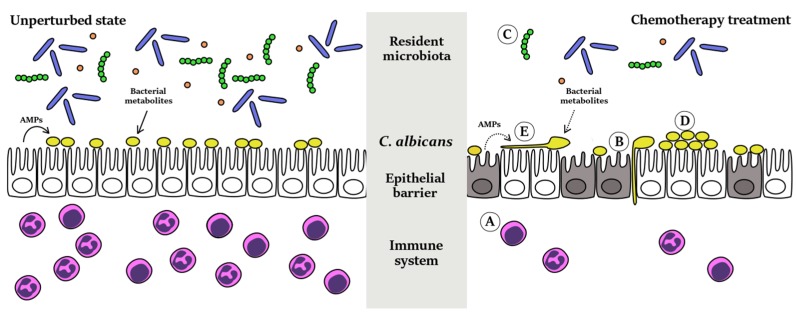Figure 1.
Pleiotropic effects of chemotherapy on the host, the microbiota, and C. albicans. The figure illustrates the physiological state in an unperturbed host asymptomatically colonized by C. albicans, and the changes that occur upon chemotherapy treatment. The grey column in the middle indicates the several points of interaction that chemotherapy makes with the host, the microbiota and the pathogen itself. Specific changes occurring during chemotherapy treatment are indicated by letters. A: The immunosuppressive effects of chemotherapeutic drugs result in the reduction in numbers and function of effector cells such as neutrophils, monocytes, macrophages, and lymphocytes, therefore weakening host defense against C. albicans. B: Maintenance and renewal of epithelial barriers is impeded by the action of chemotherapeutic agents on rapidly dividing cells. This leads to epithelial barrier disruptions that facilitate invasion by C. albicans. C: Chemotherapy may also lead to an overall reduction in microbiota abundance and/or an alteration of its composition. This may result in reduced production of bacterial metabolites that normally control colonization and virulence of C. albicans. D: Following chemotherapy, C. albicans overgrowth may occur as a result of (i) reduced production of antimicrobial peptides (AMPs) by epithelial cells and/or (ii) reduced level of bacterial metabolites that normally inhibit C. albicans growth. E: Chemotherapeutic agents might also induce hyphal formation in C. albicans, which would then facilitate invasion and entry into the bloodstream. Potential mechanisms include (i) the reduced production of certain bacterial metabolites that normally inhibit hyphal morphogenesis and/or (ii) direct effects of chemotherapy on C. albicans itself.

